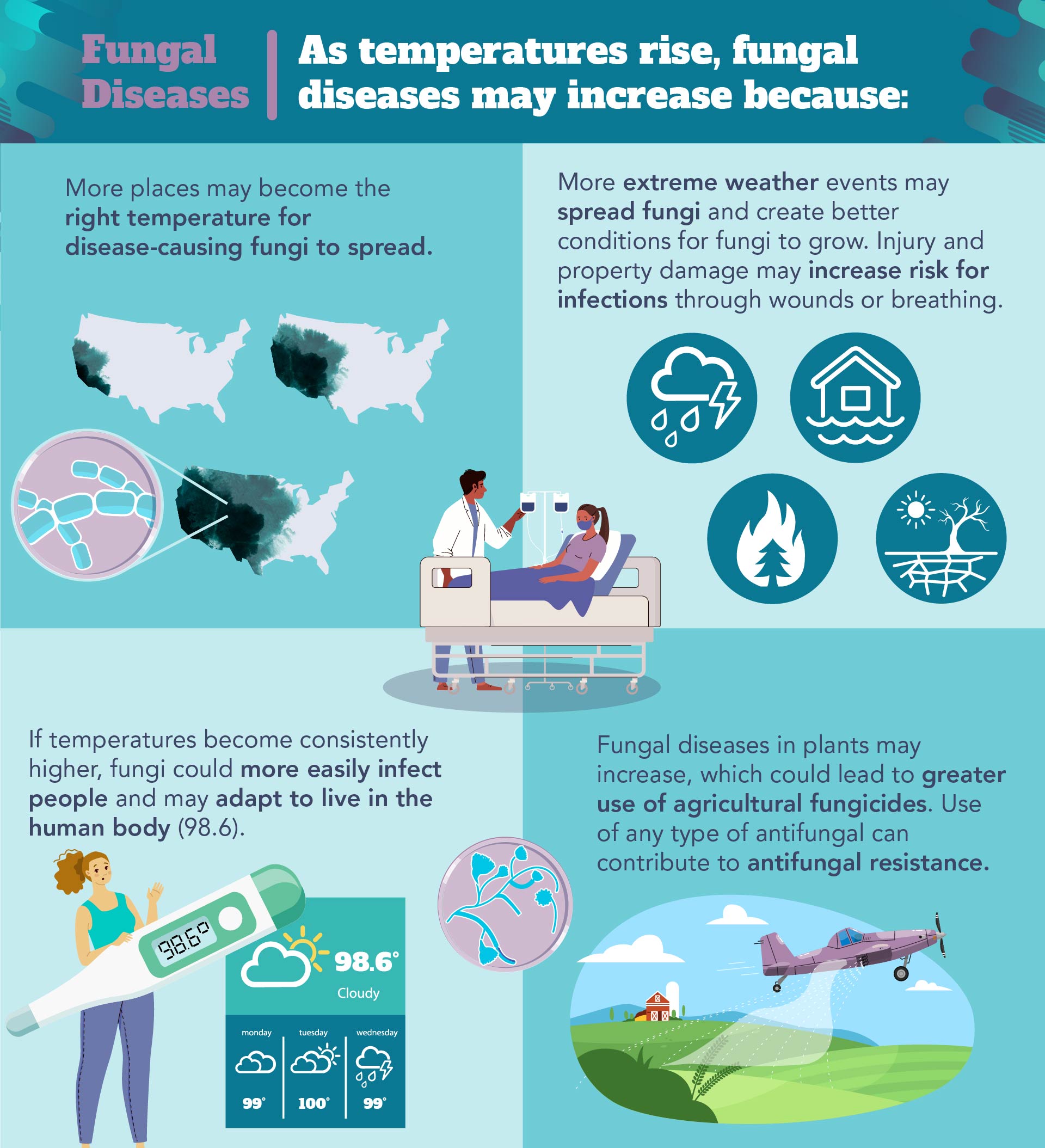Are We Underestimating The Threat Of Climate Change-Driven Fungal Infections?

Table of Contents
The Expanding Habitat of Pathogenic Fungi
Rising temperatures and humidity are creating ideal breeding grounds for fungi, expanding their geographical range and dramatically increasing the risk of infection. These changes are not subtle; they represent a significant shift in the distribution and prevalence of fungal pathogens worldwide.
H3: Rising Temperatures and Humidity:
- Increased temperatures accelerate fungal growth and reproduction, leading to larger and more frequent outbreaks. For example, Coccidioides, a fungus causing Valley Fever, is thriving in expanding arid regions due to higher temperatures and drier conditions, ironically.
- Higher humidity levels provide the necessary moisture for fungal spore germination and growth, increasing the chances of infection. This is particularly evident in regions experiencing increased rainfall and flooding, creating conditions ripe for fungal proliferation.
- Data from the past two decades shows a clear correlation between rising global temperatures and the expanding geographical range of several pathogenic fungi, including Histoplasma capsulatum (histoplasmosis) and Blastomyces dermatitidis (blastomycosis). These fungi are now being reported in areas previously considered unsuitable for their growth.
H3: Altered Ecosystems and Vector Changes:
Climate change is significantly altering ecosystems, creating new opportunities for fungal spore dispersal and infection. Changes in insect populations – potential vectors for certain fungi – are a crucial factor.
- Changes in rainfall patterns and temperature can impact insect populations, altering the distribution of vectors that carry fungal spores. This could lead to the spread of fungal diseases into new geographical areas.
- Deforestation and habitat loss due to climate change disrupt natural ecological balance, potentially increasing the prevalence of fungi that thrive in disturbed environments.
- The increasing frequency and intensity of extreme weather events, such as floods and wildfires, can disperse fungal spores over vast distances, leading to widespread exposure and outbreaks.
Increased Susceptibility in Human Populations
Climate change is not only expanding the habitat of pathogenic fungi but also increasing the vulnerability of human populations to these infections.
H3: Weakened Immune Systems:
Climate change-related factors significantly weaken immune systems, making individuals more susceptible to fungal infections.
- Malnutrition, exacerbated by climate change impacts on food security, compromises immune function, leaving individuals vulnerable to opportunistic fungal pathogens. Studies show a strong correlation between malnutrition and increased susceptibility to fungal infections, particularly in children and the elderly.
- Increased air pollution, also linked to climate change, can damage respiratory systems, further weakening immune defenses and increasing susceptibility to airborne fungal spores. Studies show a direct link between poor air quality and increased incidence of respiratory fungal infections.
- Heat stress associated with rising temperatures can also suppress the immune system, making individuals more vulnerable to fungal infections.
H3: Increased Exposure to Spores:
Changes in weather patterns increase human exposure to fungal spores, furthering the risk of infection.
- More frequent and intense storms, floods, and droughts can disrupt the soil, releasing large amounts of fungal spores into the air. These spores can be inhaled, leading to respiratory infections.
- Rising sea levels can inundate coastal areas, creating favorable conditions for the growth of waterborne fungi. This poses a significant threat to coastal communities.
- Changes in agricultural practices due to climate change can also lead to increased fungal spore production and exposure.
The Impact on Global Health and Healthcare Systems
The increased prevalence of climate change-driven fungal infections poses a significant threat to global health and healthcare systems.
H3: Increased Morbidity and Mortality:
The potential for increased rates of illness and death due to these infections is alarming, particularly among vulnerable populations.
- Mortality rates from certain fungal infections, such as invasive aspergillosis and candidiasis, are already high and are likely to increase with climate change.
- The economic burden of increased healthcare costs associated with diagnosing, treating, and managing fungal infections will strain healthcare systems worldwide.
- The emergence of antifungal-resistant strains further complicates the situation, making treatment more challenging and expensive.
H3: Challenges for Healthcare Infrastructure:
Existing healthcare infrastructure faces significant challenges in effectively addressing the escalating threat of climate change-driven fungal infections.
- Current diagnostic tools for fungal infections often lack sensitivity and specificity, delaying diagnosis and treatment. Improved diagnostic methods are urgently needed.
- The availability of effective antifungal drugs is limited, and many existing treatments have significant side effects. Development of new antifungal therapies is crucial.
- Resource allocation for research, prevention, and treatment of fungal infections needs significant improvement to address the growing problem.
Conclusion:
The underestimated threat of climate change-driven fungal infections represents a significant and growing challenge to global health. The expanding habitat of pathogenic fungi, increased human susceptibility, and the resulting strain on healthcare systems underscore the urgency of addressing this issue. We must act now to prevent the further spread of climate change-driven fungal infections. Learn more about these infections and support research efforts to improve prevention, diagnosis, and treatment. Engage in climate action to mitigate the effects of climate change on fungal disease emergence. The escalating threat of fungal infections fueled by climate change demands immediate attention and proactive solutions.

Featured Posts
-
 Is Naomi Campbell Banned From The 2025 Met Gala A Look At The Anna Wintour Conflict
May 26, 2025
Is Naomi Campbell Banned From The 2025 Met Gala A Look At The Anna Wintour Conflict
May 26, 2025 -
 10 Simple Tips For Better Tv And Streaming On Mondays
May 26, 2025
10 Simple Tips For Better Tv And Streaming On Mondays
May 26, 2025 -
 Charlene De Monaco Y Roc Agel Historia De Una Finca
May 26, 2025
Charlene De Monaco Y Roc Agel Historia De Una Finca
May 26, 2025 -
 Protecting Yourself And Your Family From Floods Severe Weather Awareness Week Day 5
May 26, 2025
Protecting Yourself And Your Family From Floods Severe Weather Awareness Week Day 5
May 26, 2025 -
 Extreme Price Hike Broadcoms V Mware Proposal Angers At And T
May 26, 2025
Extreme Price Hike Broadcoms V Mware Proposal Angers At And T
May 26, 2025
